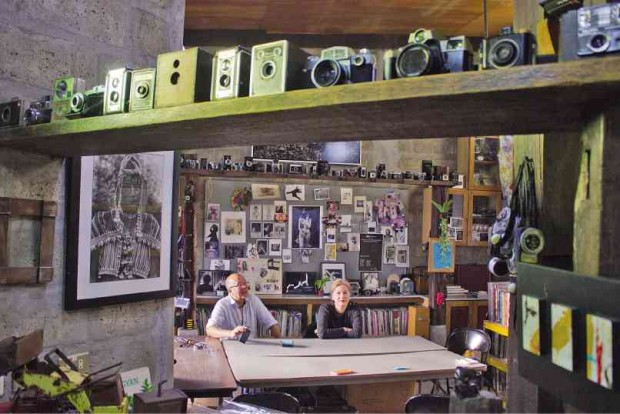‘Foto Baryo’ haven for photographers

“FOTO BARYO” founders and photography enthusiasts Fernando Afable and Maria Amor Rodriguez make teaching photography to children and province-based artists their lifelong mission. CLIFFORD NUÑEZ
Fernando Afable’s 17 years of hard work abroad ended up on a 70-square-meter bolt-hole in Tanauan City in Batangas province.
His is a unique collection of vintage cameras, displayed atop piles of hard-to-find photography books that are too many (and too rare) he already lost count. He owns camera lenses and tripods of all sorts, and about 30 photo enlargers and equipment, making up what could be one of the few remaining, functional darkrooms these days.
“Crazy, yes,” Afable said as to how he had spent his lifetime savings. But a photography haven, he called “Foto Baryo,” is just simply worth it.
Former guard
“We don’t know, we’re not a school. [But] a center or a community, maybe? We just want to share photography,” Afable, 58, said.
Article continues after this advertisementNow based in California, Afable recently visited his barrio here, his homecoming creating a bit of a buzz among Filipino photographers. During the interview, he was accompanied by his friend, Maria Amor Rodriguez, who helped him establish Foto Baryo in 2006.
Article continues after this advertisementRodriguez, however, also had to occasionally leave for Canada to attend to her personal affairs, rendering Foto Baryo closed when both are out of the country.
Afable’s interest in photography started in 1989, during the time he began working in New York City.
After entering the United States, though without proper immigration papers then, Afable found a job in a sporting goods warehouse on weekdays and worked as a security guard at International Center of Photography (ICP) in Manhattan on weekends.
ICP is a world-renowned photography institution founded in 1974 by Cornell Capa, brother of war photographer and Magnum Photos cofounder, Robert Capa.
Afable was exposed to photography and eventually promoted to overseeing ICP’s darkroom. He also became friends with several photographers who helped him get into short photography courses at the center.
“That’s how I got the idea. I wanted to put up something like an ICP and invite [photographers] to come [to the Philippines],” he said.
Flea markets
“I started collecting books and equipment. As I earned more friends, I was also able to collect more stuff: cameras, trays, enlargers—everything that had to do with a darkroom,” he said.
Piece by piece, Afable sent home balikbayan boxes containing cameras and photography books. Some of them came from rummage sales and flea markets in the United States, while others were donated by friends. When ICP transferred location, he volunteered to take care of the photo enlargers that were supposed to be discarded. He shipped them home instead.
“These were ICP’s trash,” Afable said in jest. Some garbage cans that greeted guests to Foto Baryo were marked “ICP.”
“That’s a container van worth of his lifetime’s savings,” Rodriguez said. “I remember him coming home back then without much money earned.”
Photography school
Foto Baryo was initially envisioned as a photography school for struggling artists in the provinces. Among its first projects was a trip to Mountain Province where Afable and Baguio-based photographer Tommy Hafalla taught black and white photography and photo printing, using a room in one of Sagada’s inns as an improvised darkroom.
Foto Baryo also went to a poor community in Parañaque City where Afable, with documentary photographer Emily Schiffer, taught photography to children using Polaroid film and point-and-shoot cameras.
“This child,” Afable remembered, “said he never thought how beautiful a garbage can could be until he took its photograph.”
“The reason I put this up is for photographers in the provinces,” he said.
But Foto Baryo has gone beyond that, teaching basic photography composition to a group of children with autism in Parañaque. In 2012, the latest project the group organized, Foto Baryo taught photography to the hearing-impaired in San Pablo City in Laguna province.
“We did all these without charging a single centavo,” Rodriguez said.
‘Sleeping’ but alive
“A problem is continuity. [Foto Baryo] has been sleeping for years now. There were times when I feel like losing my track. ‘Am I doing the right thing?’” Afable said.
But what keeps him going? “The thought of continuing (Cornell) Capa’s vision,” he said. The ICP founder was known for his “concerned photography,” which basically means using “humanitarian impulse” to change the world.
Foto Baryo, in recent years, has turned into a museum though access to it, at this time, is still limited.
For instance, it was where the late European Press Photo Agency chief in Manila, Dennis Sabangan, would take his students in photography for a tour. Street photographer Luis Liwanag also recently visited Foto Baryo and discussed possible projects with Afable.
Asked what he considers the most valuable item in his collection, Afable, again in jest, said: “I’m still keeping a stick of marijuana somewhere.”
Kidding aside, he said he could not name one as he considers every piece valuable “because they came from friends who supported my mission.”
Indeed, Afable’s collection, in money terms, costs “millions of pesos.” But to him, it is essentially “priceless.”